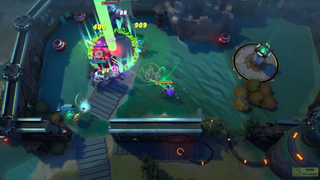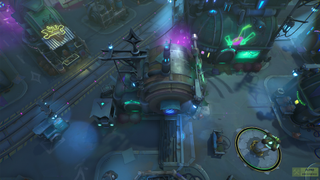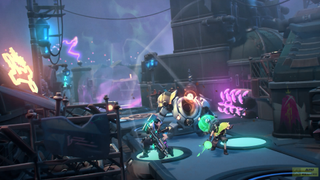If Riot Games decided to add weapons and a battle royale mode to League of Legends, it would look like the just-announced Supervive. In fact, at first glance, you’d be forgiven for thinking you’re looking at a new LoL game mode given the visual similarities between the two. Much of the Supervive team worked at Riot, including studio CEO Joe Tung, who was EVP on LoL. He came up with the basic idea for Supervive while he was there, but technical limitations meant it could never work in League.
However, Supervive has become much more than a LoL game mode, and the only real similarities now are the appearance and selection of characters with MOBA-style abilities. I tried it out in a recent hands-on session, and it’s closer to a fast-paced top-down hero shooter, where you compete as a team or solo against 39 other players in a battle royal. You’ll choose where to drop off, kill creeps to level up and collect gear, then hunt down other teams to eliminate them and be the last one standing.
“At first, the game felt a lot more like a traditional MOBA,” says Tung. “18 months later, or somewhere in that time frame, we let players play it and they unilaterally told us the game was too slow. So this is the closest thing to a reboot we’ve had on the project we took the game offline for a while and I restarted the sandbox from top to bottom Now I think the game doesn’t really share much DNA with the genre. MOBA, certainly compared to what it was before this point. Now the game feels a lot more like an action game.
Supervive moved away from some MOBA elements and as someone who has spent thousands of hours on League, Dota, and countless other MOBAs, it was hard to unlearn the things I expected. You move your character with WASD and aim your basic attacks and certain abilities with the mouse, so there’s no way to control the camera. When playing as the glass cannon in the background, it was initially annoying that my camera was almost always focused on me, while I wanted to look at the front line of the fight to see what opportunities I could take.
When I moved on to playing tanky frontline players, including my guy Kingpin who is basically a version of Dota’s Pudge or Overwatch’s Roadhog, I finally started to feel slightly useful. Throwing a huge hook, then crushing anyone who got caught with my close-range stun was satisfying and obvious enough that I could understand the impact of my abilities.

But Supervive has the same problems as MOBAs when it comes to understanding what’s happening in a fight, and after four hours I’m still having trouble reading every ability that triggers. Even when my team was doing well, winning one game and placing in the top three in the next two, I struggled to know what impact I was having outside of the most obvious abilities, and it was almost impossible to know if my basic attacks were connecting. But it took hundreds, if not thousands, of hours in Dota and LoL, so I expect the learning curve to be similar, although somewhat reduced due to the smaller roster.
Although the combat feels like a MOBA with guns, the rest of Supervive doesn’t feel like a MOBA at all. The map is huge and made up of many floating islands, with spaces between the different areas. You can fly over these gaps with your glider, which is an incredibly satisfying way to get around, but if you take damage while flying over a gap, you get stung and die instantly, which is already considered an insulting way to kill someone. ‘A. Spiked someone is one of those hype moments that really makes you feel good and I think it will become the highlight of Supervive.
“For a long time we were trying to figure out how to solve the movement problem,” Tung said. “You have a top-down camera and you have to have a large world to make the battle royale work, but traveling around the world with a top-down camera, especially with the MOBA type of movement model, is not engaging, it seems slow and not fun. (But) gliding works now and we have bypassed this whole set of problems related to the crossing, without feeling good.

Then there’s Supervive’s revive system, which has a huge impact on the game. Until the final fights where the battle royale circle brings you together, running away when a fight goes wrong is the strategy to employ. If a team member goes down, or even if your team is forced to split too much, the best strategy is never a hero play to win the fight. It’s about running away and finding a resuscitation station. Standing on it will alert nearby enemies, but if you manage to fill the progress bar, your entire team will respawn and you’ll be back in the game.
It influences every decision you make. The question always arises whether running is the best option and sneaking around after your team has fallen can be very satisfying. However, the flip side is that a single death on your team can be punishing and often the best play is for the others to turn around and run. This means that sometimes fights turn into long-range poke-fests, with each team trying to gain an ability to gain the advantage.

Hopefully when things open up to more players this will become the meta and the epic multi-team fights I’ve experienced will be few and far between because there’s too much risk involved. I hope I’m wrong, because dancing to the limit hoping an enemy walks into the wrong place isn’t that fun, while jumping around and causing chaos is.
The four hours I’ve spent with Supervive aren’t nearly enough to make any definitive statements (registration is open for a playtest that begins later this month), but I honestly believe it could represent a other 10,000 hour game, as the development team likes to pretend it will, due to the complexity. There’s a lot of potential in depth and so much to master that even after four hours I feel like I know very little and am still a complete beginner.
The foundation feels solid, the combat is inherently fun when it finally gets going, the battle royale system works surprisingly well, and most importantly, I want to play more. It’s too early to know for sure, but this could become one of the great competitive live service games of the future. But it’s a bad reputation.